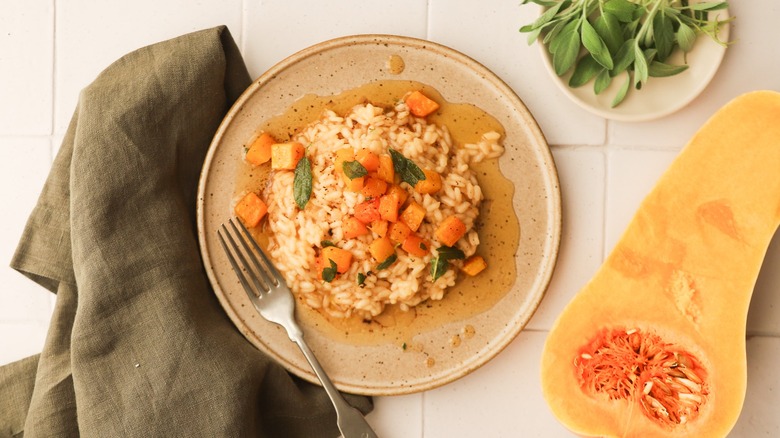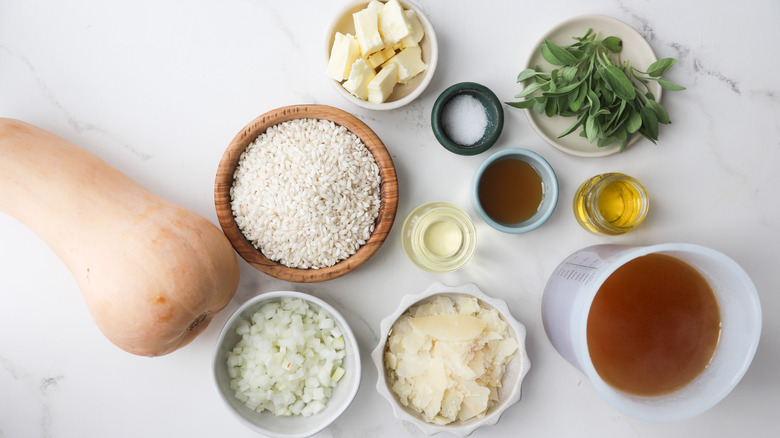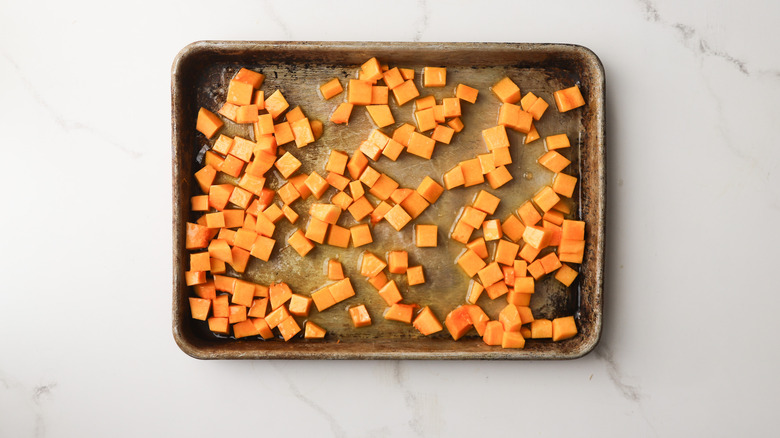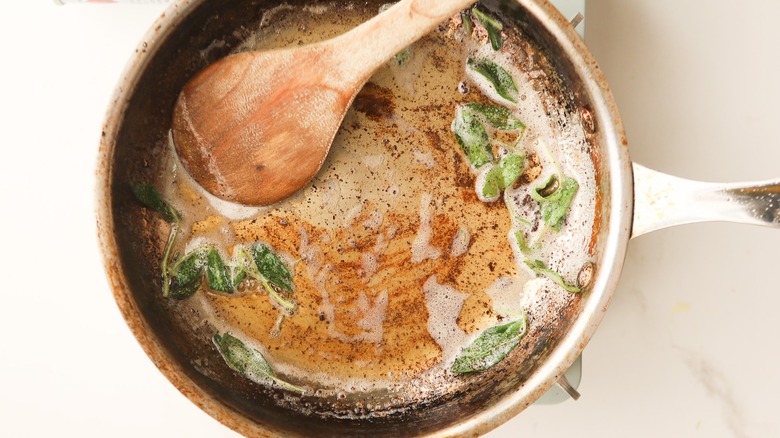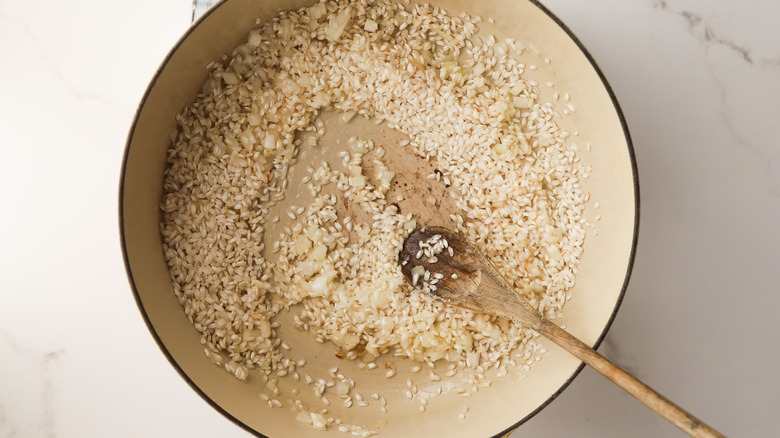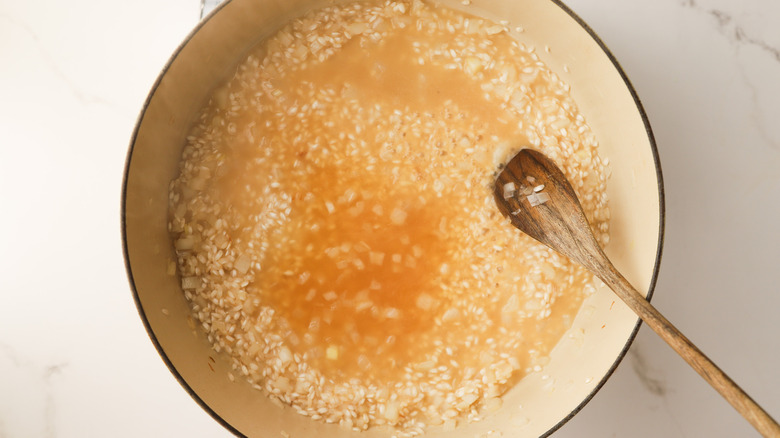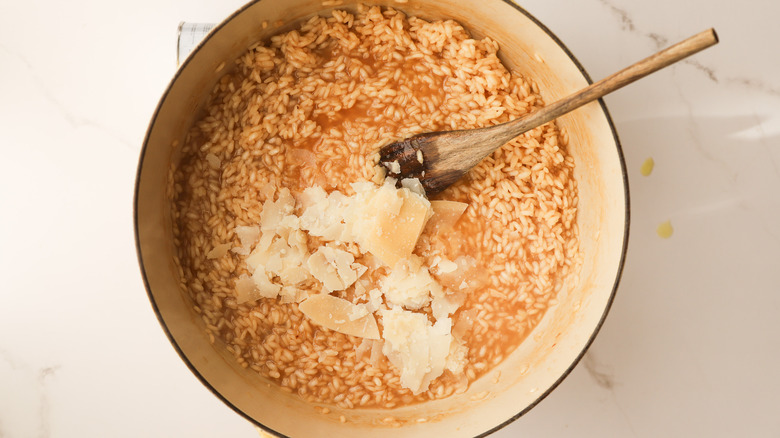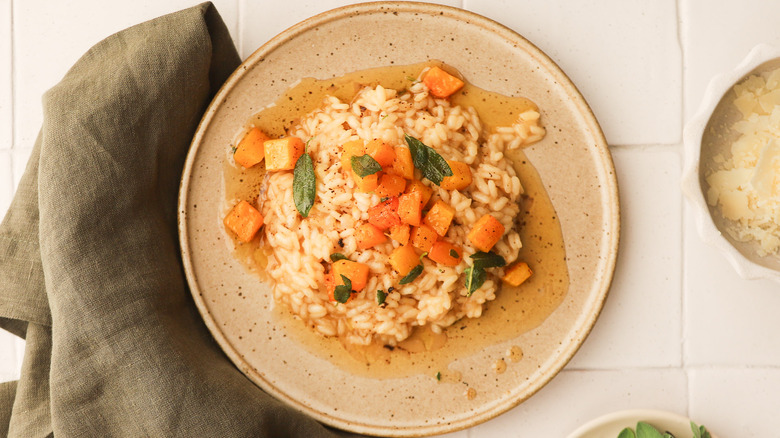Butternut Squash And Sage Risotto
A hearty plate of risotto is a thing of beauty. Risotto, characterized by its creamy consistency, is made by slowly adding hot stock to short-grain Arborio rice while constantly stirring, allowing the rice to release its starch. Not a recipe for harried weeknights, this dish takes time and attention to get right, and very few shortcuts exist, if any. The effort will payoff in the long run when you taste the delicious flavor and texture of a lovingly made plate of risotto.
This one, made by recipe developer Taylor Murray, marries a classic Parmesan risotto with caramelized butternut squash, all topped off with a brown butter and sage sauce.
The introduction of New World ingredients such as butternut squash has added depth and variation to the traditional risotto, resulting in dishes like this quintessentially Italian-American recipe. This meal is particularly popular in the autumn months when butternut squash is in season, and its sweet and nutty flavor is a perfect counterpoint to the savory, creamy rice.
Gather the ingredients for butternut squash and sage risotto
For risotto, you have to use Arborio rice. Other types will not work for this application. Arborio rice is a type of short-grain rice known for its high starch content, which gives risotto its characteristically creamy consistency. The grains absorb the flavor of the broth, wine, and other ingredients while maintaining a slight bite, or al dente texture. Butter adds a rich, creamy taste and texture to the risotto. Some of it is used for making brown butter, while the rest helps to toast the grains of rice. Onion forms part of the flavor base of the risotto. It's cooked until soft and translucent, contributing a savory note that balances the sweetness of the squash and honey. Dry white wine is used to deglaze the pan and provide acidity to the risotto, balancing the rich, creamy flavors and enhancing the overall taste.
The chicken broth is slowly absorbed by the Arborio rice throughout the cooking process, providing the liquid that allows the rice to release its starch and create the creamy texture. This forms much of the flavor of the final dish, so use a homemade broth if you can and, ideally, one fortified with extra aromatics like leek or Parmesan rind. Butternut squash provides the dish with a sweet and slightly nutty flavor, along with a soft texture that complements the creamy risotto. It's roasted with olive oil and a touch of honey to help bring out its natural sweetness.
Roast the squash
The first step is to roast the squash. Do this first so that it can cook while you make the rest of the recipe. Preheat your oven to 400 F. The high temperature causes the sugars in the squash to caramelize, adding depth of flavor and a subtle sweetness. This process is known as the Maillard reaction, and it helps to bring out a more complex taste profile in the squash. Adding honey amplifies this caramelization process. Honey not only contributes additional sweetness to the squash, but it also helps the squash to develop a beautiful, appetizing golden-brown color.
Make the brown butter sauce
To make brown butter, you start by melting butter in a skillet over medium heat. As it melts, the butter will start to foam and sizzle. At this point, it's important to pay close attention and frequently stir, as the color can change quickly from golden to burnt. You'll know your butter is ready when it takes on a rich, nutty aroma and a light brown color.
Once the butter is browned, fresh sage leaves are added. Sage is a herb with a unique, slightly peppery flavor that pairs excellently with the sweet notes of butternut squash. The leaves are cooked in the brown butter until they become crisp. Not only does this enhance the sage flavor in the butter, but the crispy sage leaves also add a delightful textural contrast to the final dish. Once you've made it, set aside while you make the risotto.
Start the risotto
Begin by melting butter in your large, heavy-bottomed pot over medium heat. Once the butter has completely melted and started to bubble slightly, it's time to add the finely chopped onion. Stir the onion into the melted butter, ensuring every piece is coated. This sautéing process allows the onion to soften and its flavors to mellow and sweeten, which forms a critical part of the risotto's flavor base. Stir occasionally, allowing the onions to cook evenly. You'll want to cook the onions until they become translucent — a key indicator that they're adequately softened and their flavor has infused into the butter. This process usually takes about 5 minutes.
Once the onions are translucent, add the Arborio rice to the pot. Stir the rice into the butter and onion mixture, ensuring each grain is well-coated. Toasting the rice is important because it allows the rice to begin absorbing flavors and helps to prevent it from becoming mushy later on. You'll let the rice toast for about 2 minutes until the edges of the grains become translucent while the center remains opaque.
Deglaze and add stock
Once the rice has been toasted, it's time to add the white wine. The addition of wine serves two main purposes: First, the acidity in the wine balances the rich, creamy, and savory flavors in the risotto, providing a bright counterpoint. Second, the process of adding and cooking off wine is known as deglazing, which removes any bits that may have stuck to the bottom of the pot during sautéing and toasting, incorporating those flavors back into the dish. Pour the wine into the pot and stir. Allow the wine to simmer until it has been mostly absorbed by the rice.
Your stock should be hot, as a sudden change in temperature can cause the rice to become hard and could adversely affect the cooking process. The stock is added a bit at a time, typically in one-cup increments. After each addition, you'll stir the risotto and wait until the liquid has been almost fully absorbed before adding the next ladleful. The reason for adding the stock gradually is because Arborio rice releases its starch into the dish slowly. This gradual release of starch, combined with the slow absorption of the stock, gives the risotto its creaminess. If you were to add all the stock at once, the rice would boil rather than simmer and wouldn't have enough time to release its starch, resulting in a dish that's more like boiled rice than creamy risotto.
Add the finishing touches
Once the risotto is creamy and the rice is al dente, remove the pot from the heat. Stir in the grated Parmesan cheese until it has fully melted into the risotto. It's important to add the Parmesan off the heat, as high heat can cause the cheese to seize up rather than melt smoothly into the dish.
The amount of salt needed can vary significantly based on the type of chicken stock used. Some stocks are already quite high in sodium, in which case you might not need to add much, if any, additional salt. Other stocks, particularly low-sodium or homemade versions, might require more additional salt. Start with a small amount, stir it in, then taste the risotto. Add more salt as needed until the flavor of the dish really pops. "Remember, it's easy to add more salt, but impossible to take it away, so always start with less than you think you might need," says Murray.
Plate it up
To finish this dish, start by equally dividing the creamy, freshly prepared risotto among four plates or shallow bowls. Be gentle while serving to maintain the creamy consistency and ensure that each grain of rice is still coated in the luscious sauce. You can use a large spoon or a ladle for this process. Aim to create a mound in the center, as risotto tends to spread a bit. While the risotto is still hot, toss the roasted butternut squash in the brown butter and sage sauce that you've prepared earlier.
Finally, carefully spoon the butternut squash covered in the brown butter and sage sauce over the top of the risotto on each plate. Try to distribute the squash evenly, so every bite of risotto will come with a piece of squash. The contrast of the sweet, buttery squash against the creamy, savory risotto will create a symphony of flavors in every bite. The texture will never be quite as it is when freshly made, but it will reheat in the microwave. Keep refrigerated for up to 5 days.
Butternut Squash and Sage Risotto
Butternut squash and sage risotto is especially great in the autumn months, with a sweet, nutty flavor being a perfect counterpoint to the savory, creamy rice.
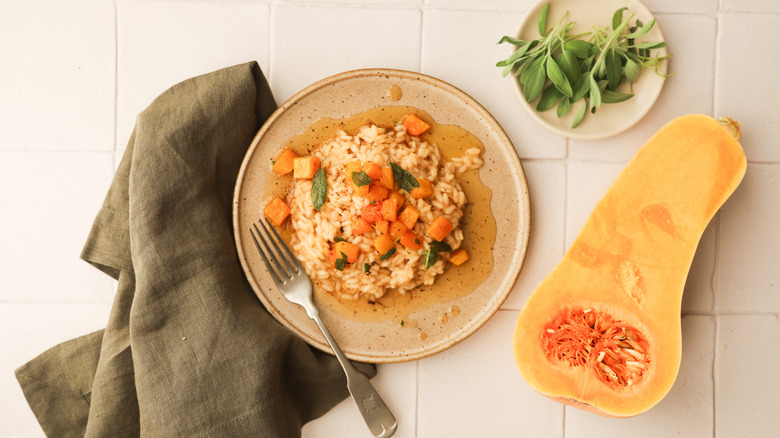
Ingredients
- 3 cups cubed butternut squash
- 2 teaspoons honey
- 1 tablespoon extra virgin olive oil
- 6 tablespoons butter, divided
- 1/3 cup fresh sage leaves
- 1/2 yellow onion, finely chopped
- 2 cups uncooked Arborio rice
- 1/2 cup dry white wine
- 8 cups hot chicken broth
- 1/2 cup grated Parmesan cheese
- 1/2 teaspoon salt
Directions
- Preheat your oven to 400 F.
- In a large mixing bowl, toss the cubed butternut squash with honey and olive oil until well coated.
- Arrange the cubes on a baking sheet in a single layer. Roast for 18-20 minutes, or until the squash is tender and slightly caramelized.
- Meanwhile, in a small skillet, melt 2 tablespoons of the butter over medium heat. Cook until butter just begins to brown, then add the sage leaves. Set aside.
- In a large, heavy bottomed pot, melt the remaining butter. Add the finely chopped onion and cook until it becomes translucent, about 5 minutes.
- Add the Arborio rice to the skillet and stir to coat with the butter and onion, letting it cook for about 2 minutes until the edges of the grains become translucent.
- Pour the white wine into the skillet and stir until it is fully absorbed by the rice.
- Add 1 cup of hot chicken broth to the rice, stirring constantly until it's absorbed. Continue adding broth 1 cup at a time, stirring continuously and letting each addition absorb before adding the next.
- After about 18-20 minutes, the rice should be tender without being mushy. Stir in the grated Parmesan cheese, and add salt.
- To serve, toss the squash with the brown butter sauce. Divide the risotto among plates and top with the brown butter squash.
Nutrition
| Calories per Serving | 908 |
| Total Fat | 33.1 g |
| Saturated Fat | 16.4 g |
| Trans Fat | 0.0 g |
| Cholesterol | 72.8 mg |
| Total Carbohydrates | 120.6 g |
| Dietary Fiber | 9.5 g |
| Total Sugars | 14.0 g |
| Sodium | 1,207.8 mg |
| Protein | 27.8 g |

